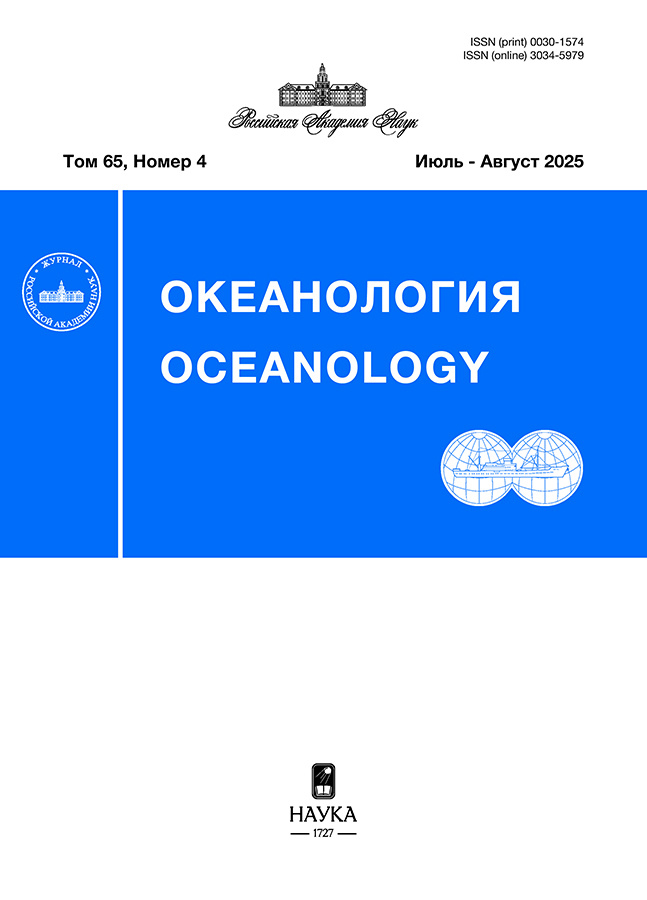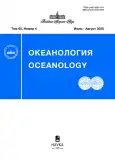Oceanology
ISSN (print): 0030-1574
The journal was founded in 1961 as a multidisciplinary journal in the field of marine science. It is the leading journal in a wide range of theoretical and experimental directions in the sciences of the ocean.
Media registration certificate: No. 0110247 dated 02/08/1993
The journal publishes original research results on physical oceanology, marine hydrochemistry, bio-oceanology and marine ecology, marine geology and geophysics, the role of the ocean in shaping the Earth's climate, information on new methods and technical means of ocean research, and information on scientific expeditions.
Founders
- Russian Academy of Sciences
- Institute of Oceanology named after. P.P.Shirshova
The journal is published under the guidance of the Department of Earth Sciences of the RAS.
Editor-in-Chief
Flint Mikhail Vladimirovich, Academician of the Russian Academy of Sciences, Doctor of Biological Sciences
Frequency / Access
6 issues per year / Subscription
Included in
White List (2nd level), Higher Attestation Commission List, RISC, Scopus, Web of Science
The journal is published in Russian and English languages. The name of the English version is Oceanology.
Current Issue
Vol 65, No 4 (2025)
Физика моря
Reconstruction of seasonal mean clouds over the world ocean using probabilistic distribution of clouds and singular spectra
Abstract
 539-547
539-547


Behavior modes of a quasi-geostrophic ellipsoidal vortex in a horizontal flow with vertical shear
Abstract
 548-568
548-568


Parameterization of thermal structure of the Black Sea active layer at the Gelendzhik study site during warm period
Abstract
 569-580
569-580


Diapycnal Exchange in the Main Pycnocline of the Black Sea
Abstract
 581-588
581-588


Химия моря
First Data on Trace Element Composition of Water and Sediment in Watercourses and Lakes of the Novaya Zemlya Archipelago
Abstract
 589-607
589-607


Features of Distribution and Composition of Organic Compounds in Bottom Sediments of the Kolyma Mouth Area
Abstract
 608-617
608-617


The effect of small doses of γ-radiation on carbon assimilation by a natural community of microplankton
Abstract
 618-626
618-626


Морская биология
Intrapopulation variability of Artemia parthenogenetica Barigozzi, 1974 (Branchiopoda, Anostraca) cysts of the Kara-Bogaz-Gol Bay of the Caspian Sea (biometry)
Abstract
 627-637
627-637


Shrimp of the Sakhalin Bay (Sea of Okhotsk): Size and sex composition and nutrition in July-August 2016–2017
Abstract
 638-647
638-647


Summer Habitat of the Bearded Seal (Erignathus barbatus) in the Western Part of the Sea of Okhotsk
Abstract
 648-653
648-653


Морская геология
Changes of terrigenous sediments in zones of contact with basalts (mouth of the California Gulf, hole DSDP 474/474A)
Abstract
 654-672
654-672


Geological structure of marine sediments around the Bennett Island according to the very high resolution seismic data
Abstract
 673-680
673-680


The formation of the modern structure of the american-antarctic ridge
Abstract
 681-693
681-693


Structure of the mid-pacific sea mountains on geomorphological and cosmogeological data
Abstract
 694-709
694-709


Structure of the Crimean shelf based on seismoacoustic profiling of the sedimentary thickness
Abstract
 710-724
710-724


Информация
Multidisciplinary Research of the Nature of the Arctic Seas: Results of the Expeditions on the R/V “Dalnie Zelentsy” in 2024
Abstract
 725-727
725-727


GEOPHYSICAL MAPPING OF THE JAPAN SEA FOR ESTIMATION OF LATE NEOGENE TECTONIC ACTIVATION IN THE 87TH CRUISE OF THE R/V “PROFESSOR GAGARINSKIY”
Abstract
 728-730
728-730












